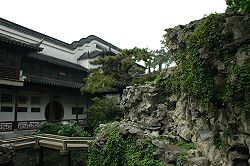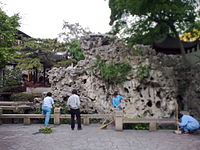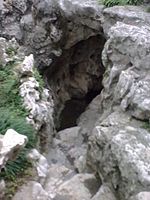- Mountain Villa with Embracing Beauty
-
Classical Gardens of Suzhou * UNESCO World Heritage Site
Country  China
ChinaType Cultural Criteria i, ii, iii, iv, v Reference 813 Region ** Asia-Pacific Inscription history Inscription 1997 (21st Session) Extensions 2000 * Name as inscribed on World Heritage List
** Region as classified by UNESCOMountain Villa with Embracing Beauty (Chinese: 环秀山庄; Pinyin: Huánxiù Shānzhuāng) is located on 272 Jingde Rd., inside the Embroidery Museum, Suzhou, Jiangsu Province. In 1997, it was recognized with other classical Suzhou gardens as a UNESCO World Heritage Site.
Contents
History
The history of Mountain Villa with Embracing Beauty may date back to Jin Dynasty, when Education Minister Wang Xun (王旬) and his brother Wang Min (王珉) donated their residential house to build Jingde Temple (景德寺). Later during Five Dynasties era, it became Jingu Garden (金谷园), owned by Qian Yuanliao (钱元璙), son of the emperor of Wuyue Kingdom, Qian Liu. In Song Dynasty, it was the pharmaceutical garden of Zhu Changwen(朱长文), a scholar. In following centuries, it was rebuilt several times. In Jiajing years of Ming Dynasty, it became Xuedao Academy of Classical Literature (学道书院), and later, the office of provisions supervisor. In 1573 CE, it was the residence of Grand Councilor, Sheng Shixing (申时行). In late Ming Dynasty and early Qing Dynasty, his descendant, Sheng Jikui (申继揆), built Qu Garden (蘧园) here.
In Qianlong's years, Qing Dynasty, it was the residence of Jiang Ji (蒋楫), director of Jurisdiction Department. Jiang built Qiuzi Tower (求自楼), and piled stones to form a rockery behind it. He dug the ground to three feet, and a spring emerged and created a pond, called Flying Snow (飞雪). Other houses and pavilions were also erected. The garden subsequently was owned by Bi Yuan (毕沅), the Imperial Secretary of State, and Sun Shiyi (孙士毅), the Chief Counselor. Sun's grandson Sun Jun, in 1807 CE, asked rockery master Ge Yuliang (戈裕良) to rebuild this garden. Ge built the rockery within a field of half mu (0.08 acre) while the effect was overwhelming as if it spread for many li. The garden gained its reputation for its rockery ever since. Wang Zhou, Director of Works, bought the garden and renamed it Mountain Villa of Embraced Beauty. In 1949 the garden became property of the government and in 1988 was declared a major historic site.
Design
The 2,180 m2 garden is composed along a linear axis with three main elements: a grotto called Autumn Hill, and Flying Snow Pool, fed by a waterfall called Flying Snow Spring, and a main hall.[1] The rock work in this garden displays every technique and effect used in Chinese gardens. In addition, it is a recreation of the five important mountains of China, and shows a mastery of creating a sense of vast space in a small area.
See also
Notes
- ^ Mingcheng, 2009
References
- Suzhou Mingcheng Information Port Co., LTD, Mountain Villa with Embracing Beauty, http://www.suzhou.gov.cn/English/Travel/8.shtml, retrieved 2009-02-30
- Yuan (袁), Xuehan (学汉); Gong Jianyi (2004), The Classical Gardens of Suzhou (苏州古典园林), CIP, pp. 217, ISBN 7214037637, http://www.book-wind.com
External links
- Classical Gardens of Suzhou, UNESCO's official website on World Heritage site.
- Terebess Hungary LLC. (2009), The Mountain Villa with Embracing Beauty, http://www.terebess.hu/kert/magankert/garden6.html, retrieved 2009
Classical Gardens of Suzhou This UNESCO World Heritage Site is inscribed as a single property, but composed of 9 separate gardens in Suzhou Prefecture Lingering Garden · Garden of Cultivation · Humble Administrator's Garden · Master of the Nets Garden · Mountain Villa with Embracing Beauty · Great Wave Pavilion · Lion Grove Garden · Couple's Retreat Garden · The Retreat & Reflection Garden
Coordinates: 31°18′47.40″N 120°36′32.04″E / 31.313167°N 120.6089°ECategories:- Buildings and structures in Suzhou
- Gardens in China
- Landscape design history of China
- World Heritage Sites in China
Wikimedia Foundation. 2010.












